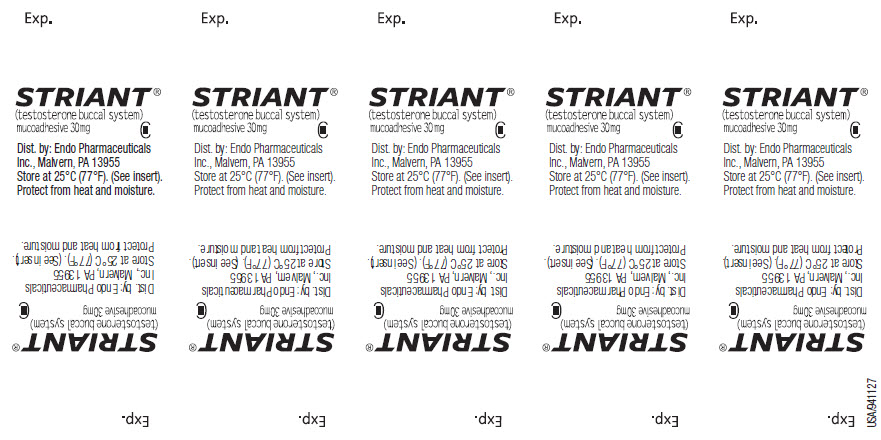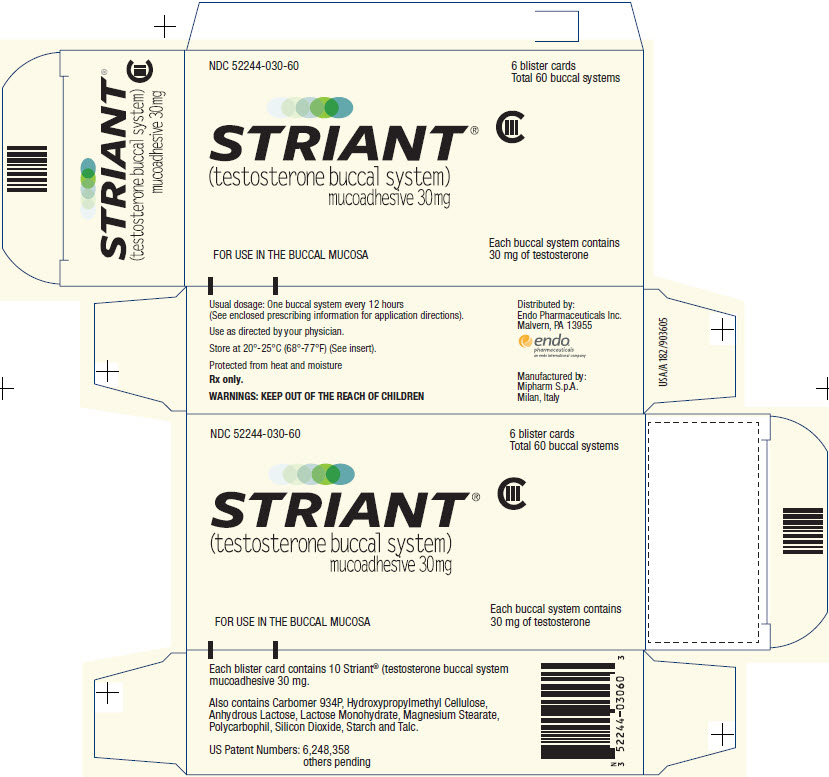STRIANT- testosterone tablet
Striant by
Drug Labeling and Warnings
Striant by is a Prescription medication manufactured, distributed, or labeled by Endo Pharmaceuticals Inc., Aspen Oss B.V., MiPharm S.p.A.. Drug facts, warnings, and ingredients follow.
Drug Details [pdf]
-
HIGHLIGHTS OF PRESCRIBING INFORMATION
These highlights do not include all the information needed to use STRIANT® safely and effectively. See full prescribing information for STRIANT.
Striant (testosterone buccal system) mucoadhesive for buccal administration, CIII
Initial U.S. Approval: 1953RECENT MAJOR CHANGES
-
Warnings and Precautions (5.6) 10/2016
INDICATIONS AND USAGE
Striant (testosterone buccal system) mucoadhesive is an androgen indicated for replacement therapy in adult males for conditions associated with a deficiency or absence of endogenous testosterone:
- Primary hypogonadism (congenital or acquired). (1)
- Hypogonadotropic hypogonadism (congenital or acquired). (1)
Limitations of use:
DOSAGE AND ADMINISTRATION
- Prior to initiating Striant, confirm the diagnosis of hypogonadism by ensuring that serum testosterone has been measured in the morning on at least two separate days and that these concentrations are below the normal range (2).
- Apply one buccal system (30 mg) to the gum region twice daily; morning and evening (about 12 hours apart). (2.1, 2.2)
- Place Striant in a comfortable position just above the incisor tooth (on either side of the mouth). (2.2)
- With each application, rotate Striant to alternate sides of the mouth. (2.2)
- Measure morning, pre-dose serum testosterone concentration at 4 to 12 weeks after initiating therapy and periodically thereafter. (2.1)
- Discontinue Striant if serum testosterone concentrations are consistently outside of the normal range.
DOSAGE FORMS AND STRENGTHS
- 30 mg per buccal system (3)
CONTRAINDICATIONS
WARNINGS AND PRECAUTIONS
- Gum-related adverse reactions: Instruct patients to regularly inspect their gum region where Striant is applied. (5.1)
- Monitor patients with benign prostatic hyperplasia (BPH) for worsening of signs and symptoms of BPH. (5.2)
- Venous thromboembolism (VTE), including deep vein thrombosis (DVT) and pulmonary embolism (PE), have been reported in patients using testosterone products. Evaluate patients with signs or symptoms consistent with DVT or PE. (5.4)
- Some postmarketing studies have shown an increased risk of myocardial infarction and stroke associated with use of testosterone replacement therapy. (5.5)
- Women and children should not use Striant (5.7)
- Exogenous administration of androgens may lead to azoospermia. (5.8)
- Edema with or without congestive heart failure may be a serious complication in patients with preexisting cardiac, renal, or hepatic disease. (5.10)
- Sleep apnea may occur in those with risk factors. (5.12)
- Monitor prostate specific antigen (PSA), hematocrit, and lipid concentrations periodically. (5.2, 5.3, 5.9, 5.13)
ADVERSE REACTIONS
- Most common adverse reactions, occurring in > 1% of patients, are gum or mouth irritation, bitter taste, gum pain, gum tenderness, headache, gum edema and taste perversion. (6.1)
To report SUSPECTED ADVERSE REACTIONS, contact Endo Pharmaceuticals, Inc. at 1-800-462-3636 or FDA at 1-800-FDA-1088 or www.fda.gov/medwatch
DRUG INTERACTIONS
- Androgens may decrease blood glucose and therefore may decrease insulin requirements in diabetic patients. (7.1)
- Changes in anticoagulant activity may be seen with androgens. More frequent monitoring of International Normalized Ratio (INR) and prothrombin time is recommended in patients taking warfarin. (7.2)
- Use of testosterone with corticosteroids may result in increased fluid retention. Use with caution, particularly in patients with cardiac, renal, or hepatic disease. (7.3)
USE IN SPECIFIC POPULATIONS
- There are insufficient long-term safety data in geriatric patients using Striant to assess the potential risks of cardiovascular disease and prostate cancer. (8.5)
See 17 for PATIENT COUNSELING INFORMATION and FDA-approved patient labeling.
Revised: 11/2016
-
-
Table of Contents
FULL PRESCRIBING INFORMATION: CONTENTS*
1 INDICATIONS AND USAGE
2 DOSAGE AND ADMINISTRATION
2.1 Dosage Information
2.2 Administration Instructions
3 DOSAGE FORMS AND STRENGTHS
4 CONTRAINDICATIONS
5 WARNINGS AND PRECAUTIONS
5.1 Gum-Related Adverse Reactions and Limited Long-Term Information on Oral Safety
5.2 Worsening of Benign Prostatic Hyperplasia (BPH) and Potential Risk of Prostate Cancer
5.3 Polycythemia
5.4 Venous Thromboembolism
5.5 Cardiovascular Risk
5.6 Abuse of Testosterone and Monitoring of Serum Testosterone Concentrations
5.7 Use in Women
5.8 Potential for Adverse Effects on Spermatogenesis
5.9 Hepatic Adverse Effects
5.10 Edema
5.11 Gynecomastia
5.12 Sleep Apnea
5.13 Lipids
5.14 Hypercalcemia
5.15 Decreased Thyroxine-binding Globulin
6 ADVERSE REACTIONS
6.1 Clinical Trials Experience
6.2 Postmarketing Experience
7 DRUG INTERACTIONS
7.1 Insulin
7.2 Oral Anticoagulants
7.3 Corticosteroids
8 USE IN SPECIFIC POPULATIONS
8.1 Pregnancy
8.3 Nursing Mothers
8.4 Pediatric Use
8.5 Geriatric Use
8.6 Renal Impairment
8.7 Hepatic Impairment
9 DRUG ABUSE AND DEPENDENCE
9.1 Controlled Substance
9.2 Abuse
9.3 Dependence
10 OVERDOSAGE
11 DESCRIPTION
12 CLINICAL PHARMACOLOGY
12.1 Mechanism of Action
12.2 Pharmacodynamics
12.3 Pharmacokinetics
13 NONCLINICAL TOXICOLOGY
13.1 Carcinogenesis, Mutagenesis, Impairment of Fertility
14 CLINICAL STUDIES
14.1 Clinical Trials in Adult Hypogonadal Males
16 HOW SUPPLIED/STORAGE AND HANDLING
17 PATIENT COUNSELING INFORMATION
17.1 Men with Known or Suspected Prostate or Breast Cancer
17.2 Gum-Related Adverse Reactions
17.3 Potential Adverse Reactions with Androgens
17.4 Patients Should be Advised of these Application Instructions
- * Sections or subsections omitted from the full prescribing information are not listed.
-
1 INDICATIONS AND USAGE
Striant is indicated for replacement therapy in adult males for conditions associated with a deficiency or absence of endogenous testosterone:
- Primary hypogonadism (congenital or acquired) – testicular failure due to cryptorchidism, bilateral torsion, orchitis, vanishing testis syndrome, orchiectomy, Klinefelter’s syndrome, chemotherapy, or toxic damage from alcohol or heavy metals. These men usually have low serum testosterone levels and gonadotropins (follicle-stimulating hormone [FSH], luteinizing hormone [LH]) above the normal range.
- Hypogonadotropic hypogonadism (congenital or acquired) – Gonadotropin or luteinizing hormone-releasing hormone (LHRH) deficiency, or pituitary hypothalamic injury from tumors, trauma, or radiation. These patients have low serum testosterone levels but have gonadotropins in the normal or low range.
Limitations of use:
- Safety and efficacy of Striant in men with “age-related hypogonadism” (also referred to as “late-onset hypogonadism”) have not been established.
- Safety and efficacy of Striant in males less than 18 years old have not been established [see Use in Specific Populations (8.4)].
-
2 DOSAGE AND ADMINISTRATION
Prior to initiating Striant, confirm the diagnosis of hypogonadism by ensuring that serum testosterone concentrations have been measured in the morning on at least two separate days and that these serum testosterone concentrations are below the normal range.
2.1 Dosage Information
The recommended dosage for Striant is the application of one buccal system (30 mg) to the gum region twice daily; morning and evening (about 12 hours apart).
To ensure proper dosing, serum testosterone concentrations should be measured. Morning, pre-dose serum testosterone concentrations should be measured at 4 to 12 weeks after initiation of therapy to ensure proper serum testosterone concentrations are achieved. Striant therapy should be discontinued if serum testosterone concentrations are consistently outside of the normal range (300 to 1050 ng/dL) despite the use of one buccal system applied twice daily.
2.2 Administration Instructions
Striant should be placed in a comfortable position just above the incisor tooth (on either side of the mouth). With each application, Striant should be rotated to alternate sides of the mouth.
Upon opening the packet, the rounded side surface of the buccal system should be placed against the gum and held firmly in place with a finger over the lip and against the product for 30 seconds to ensure adhesion. Striant is designed to stay in position until removed. If the buccal system fails to properly adhere to the gum or should fall off during the 12-hour dosing interval, the old buccal system should be removed and a new one applied.
If the buccal system falls out of position within the first 8 hours of dosing, replace with a new system and continue for a total of 12 hours from the placement of the first system. If the system falls out of position after 8 hours of dosing, a new buccal system should be applied and it may remain in place for 12 hours then continue with the next regularly scheduled dosing.
Patients should take care to avoid dislodging the buccal system. Patients should check to see if Striant is in place following consumption of food or alcoholic/non-alcoholic beverages. Striant should not be chewed or swallowed. To remove Striant, gently slide it downwards from the gum toward the tooth to avoid scratching the gum. The Striant buccal system should be removed before routine morning and evening oral care is performed, followed by application of a new buccal system.
- 3 DOSAGE FORMS AND STRENGTHS
-
4 CONTRAINDICATIONS
- Striant is contraindicated in men with carcinoma of the breast or known or suspected carcinoma of the prostate [see Warnings and Precautions (5.2) and Adverse Reactions (6.1)].
- Striant is contraindicated in women who are or may become pregnant, or who are breastfeeding. Striant may cause fetal harm when administered to a pregnant woman. Striant may cause serious adverse reactions in nursing infants. Exposure of a fetus or nursing infant to androgens may result in varying degrees of virilization [see Use in Specific Populations (8.1, 8.3)].
-
5 WARNINGS AND PRECAUTIONS
5.1 Gum-Related Adverse Reactions and Limited Long-Term Information on Oral Safety
Gum-related adverse reactions, including severe gum irritation, were reported in clinical trials of Striant. Long-term clinical trial data on gum safety is available in only a limited number of patients (117 patients, 51 patients and 48 patients with at least 6 months, 1 year, and 2 years of exposure, respectively). It is recommended that patients regularly inspect their own gum region where Striant is applied. Any abnormal finding should be brought promptly to the attention of the patient’s physician. In such circumstances, dental consultation may be appropriate.
5.2 Worsening of Benign Prostatic Hyperplasia (BPH) and Potential Risk of Prostate Cancer
- Patients with BPH treated with androgens are at an increased risk for worsening of signs and symptoms of BPH. Monitor patients with BPH for worsening signs and symptoms.
- Patients treated with androgens may be at increased risk for prostate cancer. Evaluate patients for prostate cancer prior to initiating and during treatment with androgens [see Contraindications (4) and Adverse Reactions (6.1)].
5.3 Polycythemia
Increases in hematocrit, reflective of increases in red blood cell mass, may require lowering or discontinuation of testosterone. Check hematocrit prior to initiating treatment. It would also be appropriate to re-evaluate the hematocrit 3 to 6 months after starting treatment, and then annually. If hematocrit becomes elevated, stop therapy until hematocrit decreases to an acceptable concentration. An increase in red blood cell mass may increase the risk of thromboembolic events.
5.4 Venous Thromboembolism
There have been postmarketing reports of venous thromboembolic events, including deep vein thrombosis (DVT) and pulmonary embolism (PE), in patients using testosterone products, such as Striant. Evaluate patients who report symptoms of pain, edema, warmth and erythema in the lower extremity for DVT and those who present with acute shortness of breath for PE. If a venous thromboembolic event is suspected, discontinue treatment with Striant and initiate appropriate workup and management [see Adverse Reactions (6.2)].
5.5 Cardiovascular Risk
Long term clinical safety trials have not been conducted to assess the cardiovascular outcomes of testosterone replacement therapy in men. To date, epidemiologic studies and randomized controlled trials have been inconclusive for determining the risk of major adverse cardiovascular events (MACE), such as non-fatal myocardial infarction, non-fatal stroke, and cardiovascular death, with the use of testosterone compared to non-use. Some studies, but not all, have reported an increased risk of MACE in association with use of testosterone replacement therapy in men. Patients should be informed of this possible risk when deciding whether to use or to continue to use Striant.
5.6 Abuse of Testosterone and Monitoring of Serum Testosterone Concentrations
Testosterone has been subject to abuse, typically at doses higher than recommended for the approved indication and in combination with other anabolic androgenic steroids. Anabolic androgenic steroid abuse can lead to serious cardiovascular and psychiatric adverse reactions [see Drug Abuse and Dependence (9)].
If testosterone abuse is suspected, check serum testosterone concentrations to ensure they are within therapeutic range. However, testosterone levels may be in the normal or subnormal range in men abusing synthetic testosterone derivatives. Counsel patients concerning the serious adverse reactions associated with abuse of testosterone and anabolic androgenic steroids. Conversely, consider the possibility of testosterone and anabolic androgenic steroid abuse in suspected patients who present with serious cardiovascular or psychiatric adverse events.
5.7 Use in Women
Due to lack of controlled evaluations in women and potential virilizing effects, Striant is not indicated for use in women.
5.8 Potential for Adverse Effects on Spermatogenesis
With large doses of exogenous androgens, including Striant, spermatogenesis may be suppressed through feedback inhibition of pituitary follicle-stimulating hormone (FSH) which could possibly lead to adverse effects on semen parameters including sperm count.
5.9 Hepatic Adverse Effects
Prolonged use of high doses of orally active 17-alpha-alkyl androgens (e.g., methyltestosterone) has been associated with serious hepatic adverse effects (peliosis hepatis, hepatic neoplasms, cholestatic hepatitis, and jaundice). Peliosis hepatis can be a life-threatening or fatal complication. Long-term therapy with testosterone enanthate, which elevates blood levels for prolonged periods, has produced multiple hepatic adenomas. Testosterone is not known to produce these adverse effects. Nonetheless, patients should be instructed to report any signs or symptoms of hepatic dysfunction (e.g., jaundice). If these occur, promptly discontinue Striant while the cause is evaluated.
5.10 Edema
Androgens, including Striant, may promote retention of sodium and water. Edema with or without congestive heart failure may be a serious complication in patients with preexisting cardiac, renal, or hepatic disease. In addition to discontinuation of the drug, diuretic therapy may be required [see Adverse Reactions (6.1)].
5.11 Gynecomastia
Gynecomastia may develop and persist in patients being treated with androgens, including Striant, for hypogonadism.
5.12 Sleep Apnea
The treatment of hypogonadal men with testosterone may potentiate sleep apnea in some patients especially those with risk factors such as obesity or chronic lung diseases.
5.13 Lipids
Changes in the serum lipid profile may occur. Monitor the lipid profile periodically, particularly after starting therapy.
5.14 Hypercalcemia
Androgens, including Striant, should be used with caution in cancer patients at risk of hypercalcemia (and associated hypercalciuria). Regular monitoring of serum calcium concentrations is recommended in these patients.
5.15 Decreased Thyroxine-binding Globulin
Androgens, including Striant, may decrease concentrations of thyroxine-binding globulins, resulting in decreased total T4 concentrations and increased resin uptake of T3 and T4. Free thyroid hormone concentrations remain unchanged, however, and there is no clinical evidence of thyroid dysfunction.
-
6 ADVERSE REACTIONS
6.1 Clinical Trials Experience
Because clinical trials are conducted under widely varying conditions, adverse reaction rates observed in the clinical trials of a drug can not be directly compared to rates in the clinical trials of another drug and may not reflect the rates observed in practice.
Twelve Week Clinical Trials in Hypogonadal Men
In the Phase 3, open-label study, 98 patients received Striant for up to 12 weeks. Adverse reactions to Striant reported by ≥1% of patients are listed in Table 1.
Table 1. Adverse Reactions Observed With the Use of Striant in ≥1% of Patients Adverse Reaction Striant (n=98) Gum or Mouth Irritation 9.2% Taste Bitter 4.1% Gum Pain 3.1% Gum Tenderness 3.1% Headache 3.1% Gum Edema 2.0% Taste Perversion 2.0% Gum irritation generally resolved in 1 to 8 days. Gum tenderness resolved in 1 to 14 days [see Gum-related adverse events and gum examinations in Adverse Reactions (6.1)].
The following adverse reactions to Striant occurred in 1 patient each: acne, anxiety, breast enlargement, breast pain, buccal mucosal roughening, difficulty in micturition, fatigue, gingivitis, gum blister, gustatory sense diminished, hematocrit increased, lipids serum increased, liver function tests abnormal, nose edema, stinging of lips, and toothache.
There was one additional 12-week study in 12 patients. In this study, additional adverse reactions to Striant and reported by 1 patient each included emotional lability and hypertension.
Long-Term Extension Clinical Trials in Hypogonadal Men
In two extension trials, a total of 117 and 51 patients received Striant for at least 6 months and 1 year, respectively.
Of 117 patients treated for at least 6 months, adverse reactions reported by 1 patient each included: anxiety, buccal inflammation, depression, dry mouth, gum redness, hypertension, infection, medication error, nausea, pruritus, renal function abnormal, stomatitis, taste bitter, taste perversion and toothache. Polycythemia and increased serum prostate specific antigen (PSA) were reported in three and two patients, respectively.
In these two extension studies, a total of 48 patients received Striant for at least 2 years. In these patients, adverse reactions included: gingival recession, lip ulceration, stomatitis, rash, prostate cancer, increased PSA, abdominal pain, diarrhea, hypertension aggravated, headache, nervousness, polycythemia, taste perversion, aggressiveness, hyperlipidemia, peripheral edema, and anxiety.
Gum-related adverse events and gum examinations
In the open-label study, all reported gum-related adverse events were collected and gum examinations were conducted at Baseline and every month thereafter.
A total of 16 patients reported 19 gum-related adverse reactions. Of these, ten patients (10.2%) reported 12 reactions of mild intensity, four patients (4.1%) reported 5 reactions of moderate intensity, and two patients (2.0%) reported 2 reactions of severe intensity. Four patients (4.1%) discontinued treatment with Striant due to gum or mouth-related adverse reactions including two with severe gum irritation, one with mouth irritation, and one with “bad taste in mouth.” Gum irritation generally resolved in 1 to 8 days. Gum tenderness resolved in 1 to 14 days.
Monthly gum examinations were conducted to assess for gingivitis, gum edema, oral lesions, ulcerations or leukoplakia. No cases of ulceration or leukoplakia were observed. No new oral lesions were observed. The incidence of gingivitis and gum edema was not increased during treatment.
In the two extension trials, gum examinations were conducted every 3 months while on treatment. In one of these trials, no patient had a gum abnormality, and in the other trial, moderate gingivitis and mild gum edema were reported by 1 patient each.
In these two extension studies, patient-reported information on Striant gum adherence was collected every 3 months for 1 year. At each visit, 37% to 52% of patients reported problems with Striant adhering to the gum. Circumstances surrounding Striant detachment included eating, drinking and oral care. Hot foods and hot beverages were more likely to be associated with detachment than cold food and cold beverages.
6.2 Postmarketing Experience
The following adverse reactions have been identified during post approval use of Striant. Because these reactions are reported voluntarily from a population of uncertain size, it is not always possible to reliably estimate their frequency or establish a causal relationship to drug exposure: dry mouth, gingival swelling, lip swelling, mouth ulceration, stomatitis, red blood cell increased, dysgeusia, venous thromboembolism, myocardial infarction, and stroke.
-
7 DRUG INTERACTIONS
7.1 Insulin
Changes in insulin sensitivity or glycemic control may occur in patients treated with androgens. In diabetic patients, the metabolic effects of androgens may decrease blood glucose and, therefore, may necessitate a decrease in the dose of anti-diabetic medication.
-
8 USE IN SPECIFIC POPULATIONS
8.1 Pregnancy
Pregnancy Category X: Striant is contraindicated in pregnant women or in women who may become pregnant. Testosterone is teratogenic and may cause fetal harm. Exposure of a fetus to androgens such as testosterone may result in varying degrees of virilization. If a woman becomes pregnant while taking Striant, she should be apprised of the potential hazard to the fetus.
8.3 Nursing Mothers
Although it is not known how much testosterone transfers into human milk, Striant is contraindicated in nursing women because of the potential for virilization in nursing infants. Testosterone and other androgens may adversely affect lactation.
8.4 Pediatric Use
Safety and effectiveness of Striant in males less than 18 year of age have not been established. Improper use may result in acceleration of bone age and premature closure of the epiphyses.
-
9 DRUG ABUSE AND DEPENDENCE
9.1 Controlled Substance
Striant contains testosterone, a Schedule III controlled substance in the Controlled Substances Act.
9.2 Abuse
Drug abuse is intentional non-therapeutic use of a drug, even once, for its rewarding psychological and physiological effects. Abuse and misuse of testosterone are seen in male and female adults and adolescents. Testosterone, often in combination with other anabolic androgenic steroids (AAS), and not obtained by prescription through a pharmacy, may be abused by athletes and bodybuilders. There have been reports of misuse of men taking higher doses of legally obtained testosterone than prescribed and continuing testosterone despite adverse events or against medical advice.
Abuse-Related Adverse Reactions
Serious adverse reactions have been reported in individuals who abuse anabolic androgenic steroids, and include cardiac arrest, myocardial infarction, hypertrophic cardiomyopathy, congestive heart failure, cerebrovascular accident, hepatotoxicity, and serious psychiatric manifestations, including major depression, mania, paranoia, psychosis, delusions, hallucinations, hostility and aggression.
The following adverse reactions have also been reported in men: transient ischemic attacks, convulsions, hypomania, irritability, dyslipidemias, testicular atrophy, subfertility, and infertility.
The following additional adverse reactions have been reported in women: hirsutism, virilization, deepening of voice, clitoral enlargement, breast atrophy, male-pattern baldness, and menstrual irregularities.
The following adverse reactions have been reported in male and female adolescents: premature closure of bony epiphyses with termination of growth, and precocious puberty.
Because these reactions are reported voluntarily from a population of uncertain size and may include abuse of other agents, it is not always possible to reliably estimate their frequency or establish a causal relationship to drug exposure.
9.3 Dependence
Behaviors Associated with Addiction
Continued abuse of testosterone and other anabolic steroids, leading to addiction is characterized by the following behaviors:
- Taking greater dosages than prescribed
- Continued drug use despite medical and social problems due to drug use
- Spending significant time to obtain the drug when supplies of the drug are interrupted
- Giving a higher priority to drug use than other obligations
- Having difficulty in discontinuing the drug despite desires and attempts to do so
- Experiencing withdrawal symptoms upon abrupt discontinuation of use
Physical dependence is characterized by withdrawal symptoms after abrupt drug discontinuation or a significant dose reduction of a drug. Individuals taking supratherapeutic doses of testosterone may experience withdrawal symptoms lasting for weeks or months which include depressed mood, major depression, fatigue, craving, restlessness, irritability, anorexia, insomnia, decreased libido and hypogonadotropic hypogonadism.
Drug dependence in individuals using approved doses of testosterone for approved indications has not been documented.
-
10 OVERDOSAGE
There is one report of acute overdosage with testosterone enanthate injection: testosterone levels of up to 11,400 ng/dL were implicated in a cerebrovascular accident.
Oral ingestion of Striant is not expected to result in clinically significant serum testosterone concentrations due to extensive first-pass (hepatic) metabolism.
Treatment of overdosage would consist of discontinuation of Striant together with appropriate symptomatic and supportive care.
-
11 DESCRIPTION
Striant (testosterone buccal system) mucoadhesive is for buccal administration only. It contains testosterone, an androgen.
Striant is designed to adhere to the gum or inner cheek. It provides a controlled and sustained release of testosterone through the buccal mucosa as the buccal system gradually hydrates. Application of Striant twice a day, in the morning and in the evening, provides continuous systemic delivery of testosterone.
Striant is a white to off-white colored, monoconvex, tablet-like, mucoadhesive buccal system. Striant adheres to the gum tissue above the incisors, with the flat surface facing the cheek mucosa.
The active ingredient in Striant is testosterone (see Figure 1). Each buccal system contains 30 mg of testosterone. Testosterone USP is practically white crystalline powder chemically described as 17-beta hydroxyandrost-4-en-3-one.
Figure 1: Chemical Structure of Testosterone
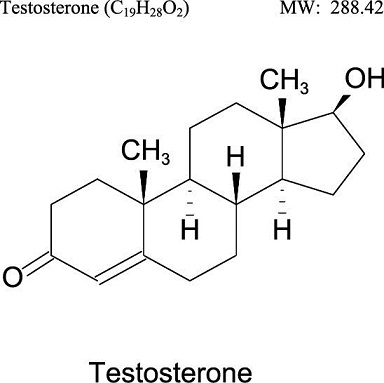
Other pharmacologically inactive ingredients in Striant are anhydrous lactose NF, carbomer 934P, hypromellose USP, magnesium stearate NF, lactose monohydrate NF, polycarbophil USP, colloidal silicon dioxide NF, starch NF and talc USP.
-
12 CLINICAL PHARMACOLOGY
12.1 Mechanism of Action
Endogenous androgens, including testosterone and dihydrotestosterone (DHT), are responsible for the normal growth and development of the male sex organs and for maintenance of secondary sex characteristics. These effects include the growth and maturation of prostate, seminal vesicles, penis and scrotum; the development of male hair distribution, such as facial, pubic, chest and axillary hair; laryngeal enlargement, vocal chord thickening, alterations in body musculature and fat distribution. Testosterone and DHT are necessary for the normal development of secondary sex characteristics.
Male hypogonadism, a clinical syndrome resulting from insufficient secretion of testosterone, has two main etiologies. Primary hypogonadism is caused by defects of the gonads, such as Klinefelter’s syndrome or Leydig cell aplasia, whereas secondary hypogonadism is the failure of the hypothalamus (or pituitary) to produce sufficient gonadotropins (FSH, LH).
12.3 Pharmacokinetics
Absorption
When applied to the buccal mucosa, Striant releases testosterone, allowing for absorption of testosterone through gum and cheek surfaces that are in contact with the buccal system. Since venous drainage from the mouth is to the superior vena cava, trans-buccal delivery of testosterone circumvents first-pass (hepatic) metabolism.
Following the initial application of Striant, the serum testosterone concentration rises to a maximum within 10-12 hours. The mean maximum (Cmax) and mean average serum total testosterone concentrations for the 12 hour dosing period (Cavg(0-12)) are within the normal physiologic range.
Striant is intended for twice daily dosing. Serum concentrations of testosterone reach steady-state levels after the second dose of twice daily Striant dosing. Following removal of Striant, the serum testosterone concentration decreases to a level below the normal range within 2-4 hours.
Figure 2. Mean (SD) total testosterone concentration-time curves on Day 7 (after 7 days of Striant treatment, n=29)
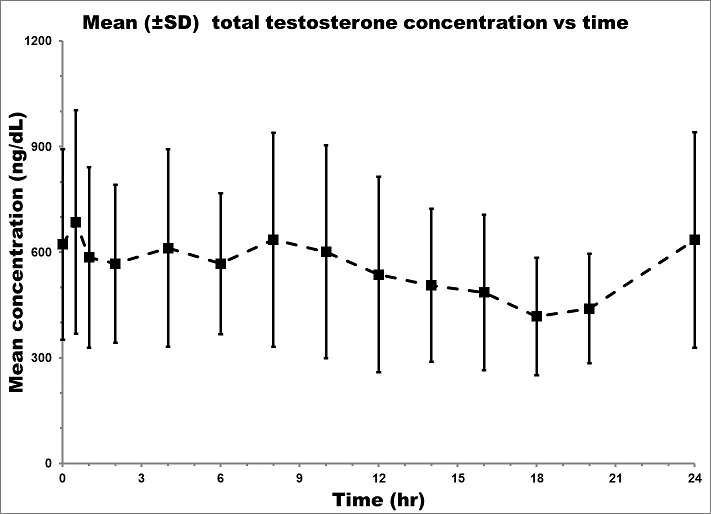
Although no specific food effect study was conducted, Phase 3 study results showed that consumption of food and beverage did not significantly affect the absorption of testosterone from Striant.
The effects of toothbrushing, mouthwashing, chewing gum and alcoholic beverages on the use and absorption of Striant were not investigated in controlled studies. However, Phase 3 clinical studies permitted patients to do these activities indicating the use of Striant was not significantly affected by these activities.
Distribution
Circulating testosterone is chiefly bound in the serum to sex hormone-binding globulin (SHBG) and albumin. Approximately 40% of testosterone in plasma is bound to SHBG, 2% remains unbound (free) and the rest is bound to albumin and other proteins.
Metabolism
Testosterone is metabolized to various 17-keto steroids through two different pathways, and the major active metabolites are estradiol and dihydrotestosterone (DHT).
Mean DHT concentrations increased in parallel with testosterone concentrations during Striant treatment. After 24 hours of treatment, mean (SD) DHT serum concentrations was approximately 80 (50) ng/dL. The mean steady-state T/DHT ratio during treatment with Striant ranged approximately 9-12.
Excretion
There is considerable variation in the half-life of testosterone as reported in the literature, ranging from 10 to 100 minutes. About 90% of a dose of testosterone given intramuscularly is excreted in the urine as glucuronic and sulfuric acid conjugates of testosterone and its metabolites; about 6% of a dose is excreted in the feces, mostly in the unconjugated form. Inactivation of testosterone occurs primarily in the liver.
Geriatrics
In patients 65 years of age and older, the total testosterone Cavg(0-24) value was higher by 13% compared to patients <65 years of age. In addition, the total T to DHT area-under-the curve ratio was lower in the older population compared to the younger population by 16%. These differences may not be clinically significant.
-
13 NONCLINICAL TOXICOLOGY
13.1 Carcinogenesis, Mutagenesis, Impairment of Fertility
Carcinogenicity
Testosterone has been tested by subcutaneous injection and implantation in mice and rats. In mice, the implant induced cervical-uterine tumors, which metastasized in some cases. There is suggestive evidence that injection of testosterone into some strains of female mice increases their susceptibility to hepatoma. Testosterone is also known to increase the number of tumors and decrease the degree of differentiation of chemically induced carcinomas of the liver in rats.
Mutagenesis
Testosterone was negative in the in vitro Ames and in the in vivo mouse micronucleus assays.
Impairment of Fertility
The administration of exogenous testosterone has been reported to suppress spermatogenesis in the rat, dog and non human primates, which was reversible on cessation of the treatment.
-
14 CLINICAL STUDIES
14.1 Clinical Trials in Adult Hypogonadal Males
Striant was evaluated in a multicenter, open-label Phase 3 trial in 98 hypogonadal men. In this study, 30 mg of Striant was administered buccally twice daily for 12 weeks. The mean age was 53.6 years (range 20 to 75 years). Overall, 69% of patients were Caucasian, 9% were African-American, 15% were Hispanic, 4% were Asian, and 2% were of another ethnic origin. At baseline, 10% of patients reported current use of tobacco and 42% drank alcohol.
Of 82 patients who completed the trial and had sufficient data for full analysis, 86.6% had mean serum testosterone concentration (Cavg(0-24)) values within the physiologic range (300-1050 ng/dL).
The mean (±SD) time-averaged steady-state daily testosterone concentration (Cavg(0-24)) at Day 84 was 520 (±205) ng/dL compared with a mean of 149 (±99) ng/dL at Baseline. The mean (±SD) maximum testosterone concentration (Cmax) at Day 84 was 970 (±442) ng/dL. At Day 84, the mean percentage of time over the 24-hour sampling period that total testosterone concentrations remained within the normal range of 300-1050 ng/dL was 76%.
Figure 3 shows the mean total testosterone serum concentration versus time curves on Day 84 (after 12 weeks of Striant treatment).
Figure 3. Mean (SD) total testosterone concentration-time curves on Day 84 (after 12 weeks of Striant treatment, n=82)
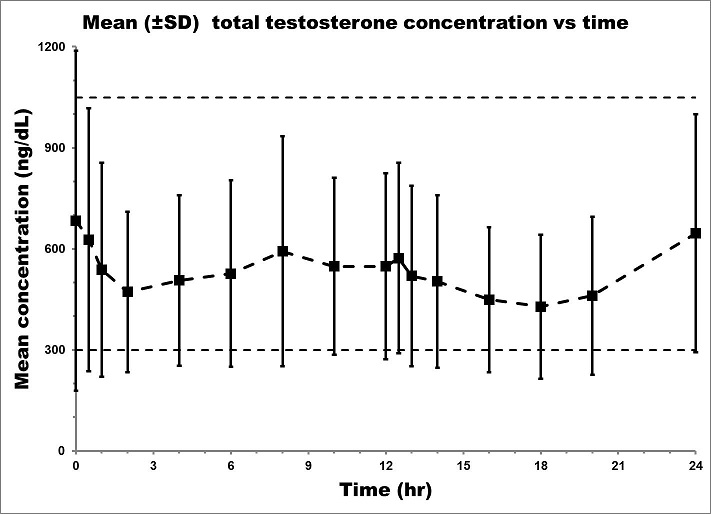
Mean DHT concentrations increased in parallel with testosterone concentrations, with the total testosterone/DHT ratio (9-12) indicating no alteration in metabolism of testosterone to DHT in testosterone deficient men treated with Striant.
During continuous treatment there was no accumulation of testosterone, and mean total testosterone, free testosterone, and DHT were maintained within their physiologic ranges.
-
16 HOW SUPPLIED/STORAGE AND HANDLING
Striant (testosterone buccal system) mucoadhesive is supplied in transparent blister packs containing 10 doses. It is white to off-white colored with a flat edge on one side and a convex surface on the other.
Striant is debossed on its flat side, as shown below:

Each Striant buccal system contains 30 mg of testosterone and is supplied as follows:
NDC Number Package Size 52244-030-60 6 blister packs,
10 buccal systems per blister pack,
30 mg of testosterone per buccal systemStore at 20-25°C (68-77°F) [see USP Controlled Room Temperature]. Protect from heat and moisture. Damaged blister packages should not be used. Discard used Striant buccal systems in household trash in a manner that prevents accidental application or ingestion by children or pets.
-
17 PATIENT COUNSELING INFORMATION
See FDA-Approved Patient Labeling (Patient Information).
Patients should be informed of the following:
17.1 Men with Known or Suspected Prostate or Breast Cancer
Men with known or suspected prostate or breast cancer should not use Striant [see Contraindications (4) and Warnings and Precautions (5.2)].
17.2 Gum-Related Adverse Reactions
Gum-related adverse reactions, including severe gum irritation, were reported in clinical trials of Striant. Advise patients to regularly inspect the gum region where they apply Striant and to report any abnormality to their health care professional.
17.3 Potential Adverse Reactions with Androgens
Patients should be informed that treatment with androgens, such as Striant, may lead to adverse reactions that include:
- Changes in urinary habits such as increased urination at night, trouble starting their urine stream, passing urine many times during the day, having an urge that they have to go to the bathroom right away, having a urine accident, being unable to pass urine and having a weak urine flow
- Breathing disturbances, including those associated with sleep, or excessive daytime sleepiness
- Too frequent or persistent erections of the penis
- Nausea, vomiting, changes in skin color, or ankle swelling
17.4 Patients Should be Advised of these Application Instructions
- Advise patients to carefully read the patient information accompanying each carton of Striant blister packaged tablets.
- Morning and evening oral care should be timed to coincide with removal of the residual old system and application of a new buccal system.
- Before morning and evening oral care, the residual Striant buccal system residual should be removed, then oral care should be performed.
- Following oral care, a new buccal system should be applied.
- Upon opening the packet, the rounded side surface of the buccal system should be placed against the gum and held firmly in place with a finger over the lip and against the product for 30 seconds to ensure adhesion.
- Striant should be placed in a comfortable position just above the incisor tooth (on either side of the mouth). With each application, Striant should be rotated to alternate sides of the mouth.
- Striant is designed to stay in position until removed. If the buccal system fails to properly adhere to the gum or falls off within the first 8 hours of dosing, replace with a new system and continue for a total of 12 hours for the placement of the first system. If the system falls out of position after 8 hours of dosing, a new buccal system should be applied and it may remain in place for 12 hours then continue with the next regularly scheduled dosing.
- Patients should take care to avoid dislodging the buccal system. Patients should check to see if Striant is in place following consumption of food or alcoholic/non-alcoholic beverages. Striant should not be chewed or swallowed.
Distributed by:
Endo Pharmaceuticals Inc.
Malvern, PA 19355Manufactured by:
Mipharm S.p.A.
Milan, ItalyUS Patent Numbers: 6,248,358 and 8,765,177
© 2016 Endo Pharmaceuticals Inc. All rights reserved.
USA/933221
-
Patient InformationSTRIANT® (STRI’ ant) CIII(testosterone buccal system)mucoadhesive
Read this Patient Information before you start using Striant and each time you get a refill. There may be new information. This information does not take the place of talking with your healthcare provider about your medical condition or your treatment.
What is Striant?
Striant is prescription medicine that contains testosterone. Striant is used to treat adult males who have low or no testosterone due to certain medical conditions.
Your healthcare provider will test your blood for testosterone before you start and while you are using Striant.
It is not known if Striant is safe or effective to treat men who have low testosterone due to aging.
It is not known if Striant is safe and effective in children younger than 18 years old. Improper use of testosterone may affect bone growth in children.
Striant is a controlled substance (CIII) because it contains testosterone that can be a target for people who abuse prescription medicines. Keep your Striant in a safe place to protect it. Never give your Striant to anyone else, even if they have the same symptoms you have. Selling or giving away this medicine may harm others and it is against the law.
Striant is not meant for use by women.
Who should not use Striant?
Do not use Striant if you:
- are a man who has breast cancer
- have or might have prostate cancer
- are pregnant or may become pregnant or are breastfeeding. Striant may harm your unborn or breastfeeding baby.
Talk to your healthcare provider before using this medicine if you have any of the above conditions.
What should I tell my healthcare provider before using Striant?
Before you use Striant, tell your healthcare provider if you:
- have breast cancer
- have or might have prostate cancer
- have problems urinating due to an enlarged prostate
- have heart problems
- have kidney or liver problems
- have problems breathing while you sleep (sleep apnea)
- have diabetes
- have any other medical conditions
Tell your healthcare provider about all the medicines you take, including prescription and non-prescription medicines, vitamins, and herbal supplements.
Using Striant with other medicines can affect each other. Especially tell your healthcare provider if you take:
- insulin
- medicines that decrease blood clotting
- corticosteroids
Know the medicines you take. Ask your healthcare provider or pharmacist for a list of all your medicines if you are not sure. Keep a list of them and show it to your healthcare provider and pharmacist when you get a new medicine.
How should I use Striant?
- Apply Striant exactly as your healthcare provider tells you to.
- Striant is applied 1 time in the morning (after your routine oral care) and 1 time in the evening (about 12 hours apart).
- Change (rotate) your application site to the other side of your mouth with each application.
- Striant should stay on the application site until you take it off. If your Striant becomes loose or falls off, throw it away and put on a new one.
- Check to make sure that Striant is still in place after you brush your teeth, use mouthwash, or have anything to eat or drink.
- Do not chew or swallow Striant.
- Remove Striant by gently sliding it to the front or back of your mouth to loosen it. Then slide it downwards from your gum to your tooth. This will avoid scratching the gum.
Applying Striant:
- Striant is to be applied to your upper gum, just above either the left or right incisor tooth. The incisor is the tooth just to the right or left of your 2 front teeth.
-
Remove your Striant from the package. Tear off 1 Striant. Start at the corner tab and peel off paper backing (See Figure A).
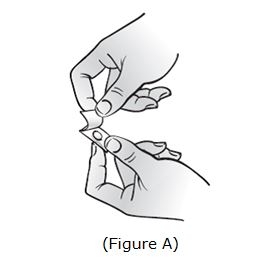
- Push Striant through the foil from the front (See Figure B).
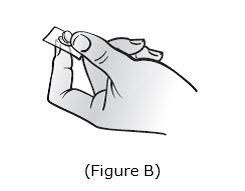
- Push Striant through the foil from the front (See Figure B).
-
Check Striant. Striant is curved on one side and flat on the other side. The flat side has the letter “A” marked on it (See Figure C).
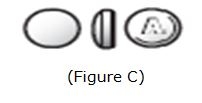
-
Apply Striant. Place the flat side of the Striant on your fingertip (See Figure D).
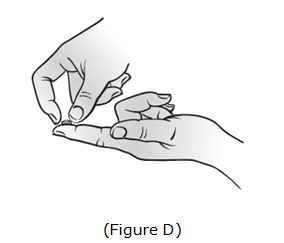
- Gently place the curved side of Striant against your upper gum, then push Striant up as high as it will go on your gum (See Figure E).
- The flat side of Striant should be facing your cheek.
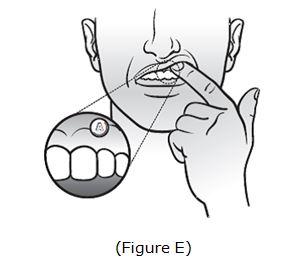
-
Hold Striant in place for 30 seconds. Using your finger, push down on the outside of your upper lip over the application site for 30 seconds (See Figure F). This will help Striant to stick to the application site.
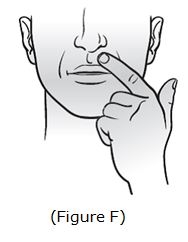
What are the possible side effects of Striant?
Striant can cause serious side effects including:
- Gum problems. Striant can cause severe gum irritation. You should check your gums often and tell your healthcare provider right away if you notice any signs of gum problems.
-
If you already have an enlargement of your prostate gland, your signs and symptoms may get worse while using Striant. This can include:
- increased urination at night
- trouble starting your urine stream
- having to pass urine many times during the day
- having an urge that you have to go to the bathroom right away
- having a urine accident
- being unable to pass urine or weak urine flow
- Possible increased risk of prostate cancer. Your healthcare provider should check you for prostate cancer or other prostate problems before you start and while you use Striant.
- Blood clots in the legs or lungs. Signs and symptoms of a blood clot in your leg can include leg pain, swelling or redness. Signs and symptoms of a blood clot in your lungs can include difficulty breathing or chest pain.
- Possible increased risk of heart attack or stroke.
- In large doses Striant may lower your sperm count.
- Swelling of your ankles, feet or body, with or without heart failure
- Enlarged or painful breasts
- Problems breathing while you sleep (sleep apnea).
Tell your healthcare provider right away if you have any of the serious side effects listed above.
The most common side effects of Striant include:
- a change in how food tastes to you or an unusual or bitter taste in your mouth
- gum pain, tenderness, or swelling
- headache
Other side effects include more erections than are normal for you or erections that last a long time.
Tell your healthcare provider if you have any side effect that bothers you or that does not go away.
These are not all the possible side effects of Striant. For more information, ask your healthcare provider or pharmacist.
Call your doctor for medical advice about side effects. You may report side effects to FDA at 1-800-FDA-1088.
How should I store Striant?
- Keep Striant at room temperature between 68°F to 77°F (20°C to 25°C).
- Keep Striant dry and away from heat.
- Do not use a damaged blister package. If your Striant blister package is damaged, throw it away and get a new one.
- Safely throw away your used Striant in the household trash.
Keep Striant and all medicines out of the reach of children and pets.
General information about the safe and effective use of Striant.
Medicines are sometimes prescribed for purposes other than those listed in a Patient Information leaflet. Do not use Striant for a condition for which it was not prescribed. Do not give Striant to other people, even if they have the same symptoms you have. It may harm them.
This Patient Information leaflet summarizes the most important information about Striant. If you would like more information, talk with your healthcare provider. You can ask your healthcare provider or pharmacist for information about Striant that is written for health professionals.
For more information go to www.striant.com or call 1-800-462-3636.
What are the ingredients in Striant?
Active Ingredient: testosterone
Inactive Ingredients: anhydrous lactose NF, carbomer 934P, hypromellose USP, magnesium stearate NF, lactose monohydrate NF, polycarbophil USP, colloidal silicon dioxide NF, starch NF, and talc USP.
This Patient Information has been approved by the U.S. Food and Drug Administration.
Rx Only
Distributed by:
Endo Pharmaceuticals Inc.
Malvern, PA 19355Manufactured by:
Mipharm S.p.A.
Milan, ItalyUS Patents Numbers: 6,248,358 and 8,765,177
© 2016 Endo Pharmaceuticals Inc.
Revised: 10/2016
USA/933221
- PRINCIPAL DISPLAY PANEL
- PRINCIPAL DISPLAY PANEL
-
INGREDIENTS AND APPEARANCE
STRIANT
testosterone tabletProduct Information Product Type HUMAN PRESCRIPTION DRUG Item Code (Source) NDC: 52244-030 Route of Administration BUCCAL DEA Schedule CIII Active Ingredient/Active Moiety Ingredient Name Basis of Strength Strength TESTOSTERONE (UNII: 3XMK78S47O) (TESTOSTERONE - UNII:3XMK78S47O) TESTOSTERONE 30 mg Product Characteristics Color WHITE Score no score Shape ROUND Size 9mm Flavor Imprint Code A Contains Packaging # Item Code Package Description Marketing Start Date Marketing End Date 1 NDC: 52244-030-60 6 in 1 BOX 06/19/2003 05/31/2020 1 10 in 1 BLISTER PACK; Type 0: Not a Combination Product Marketing Information Marketing Category Application Number or Monograph Citation Marketing Start Date Marketing End Date NDA NDA021543 06/19/2003 05/31/2020 Labeler - Endo Pharmaceuticals Inc. (178074951) Establishment Name Address ID/FEI Business Operations Aspen Oss B.V. 491013870 API MANUFACTURE(52244-030) Establishment Name Address ID/FEI Business Operations MiPharm S.p.A. 514042399 ANALYSIS(52244-030) , MANUFACTURE(52244-030) , RELABEL(52244-030) , REPACK(52244-030)
Trademark Results [Striant]
Mark Image Registration | Serial | Company Trademark Application Date |
|---|---|
 STRIANT 76442855 2795914 Live/Registered |
ACTIENT PHARMACEUTICALS LLC 2002-08-19 |
 STRIANT 76151225 not registered Dead/Abandoned |
BROADBAND OFFICE, INC. 2000-10-20 |
© 2025 FDA.report
This site is not affiliated with or endorsed by the FDA.

